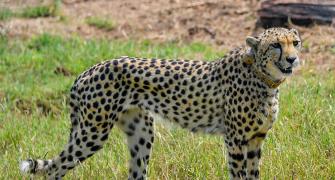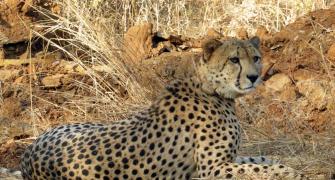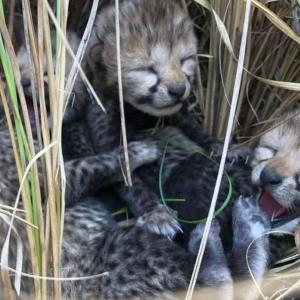India considered sourcing new cheetahs from Somalia, Tanzania, Sudan and other range countries closer to the equator or in the Northern Hemisphere to avoid biorhythm complications observed in big cats brought from Southern Hemisphere countries like South Africa and Namibia, according to official records.

Due to the differences in circadian rhythms between the Northern and Southern Hemispheres, some cheetahs developed thick winter coats during the Indian summer and monsoon last year, anticipating the African winter (June to September).
Three of these cheetahs -- a Namibian female and two South African males -- died after wounds beneath their winter coats, on their backs and necks, became infested with maggots and led to blood infections.
PTI has learnt from sources that the cheetahs from Namibia and South Africa have once again developed thick winter coats. Despite these concerns, discussions are ongoing with Southern Hemisphere countries to bring new cheetahs.
"Talks are ongoing with all countries, including South Africa and Namibia, but we have not formally approached anyone. Currently, our focus is on addressing immediate issues, such as augmenting the prey base, managing the leopard population and readying the Gandhi Sagar Wildlife Sanctuary," a source told PTI.
Documents obtained by PTI through an RTI application revealed that during a steering committee meeting on August 10 last year, chairman Rajesh Gopal said the time it takes for cheetahs from Southern Hemisphere countries to adjust their biorhythms to the local environment, climate, and conditions in Madhya Pradesh's Kuno National Park might be a significant factor in their deaths.
"For want of biorhythmic adjustment, some cheetahs have succumbed to ectoparasitic infections during their pelage change, which was synced with the climate conditions of their earlier habitat. The third filial generation from surviving cheetahs would be more resistant and better adapted to Kuno conditions," Gopal said in the meeting.
He acknowledged the possibility of further mortality due to this issue and recommended that "future cheetahs for reintroduction should be sourced from Northern Hemisphere countries like Kenya or Somalia to avoid biorhythmic complications".
According to the Africa Range-Wide Cheetah Conservation Initiative, Southern and Eastern Africa are strongholds for the species, although there has been significant range loss in parts of these regions.
The current distribution in several countries, such as Sudan, Somalia, Eritrea, Angola, Mozambique, and Zambia, remains largely unknown.
In a meeting of the steering committee on September 4, Gopal reiterated the importance of syncing biorhythms, particularly circadian rhythms, with local climatic conditions.
He emphasised that cheetahs from South Africa are adapted to the climatic conditions of the Southern Hemisphere, which has a different climate regime.
Therefore, it is crucial that the National Tiger Conservation Authority prioritise sourcing new cheetahs from Northern Hemisphere countries like Kenya and Somalia.
The taxonomic variation between subspecies is not particularly significant, "since the cheetahs from South Africa also belong to a different subspecies", he said.
In another meeting on October 27, the committee stressed that cheetahs should not be sourced from Southern Hemisphere African countries, based on experiences related to circadian rhythm adjustments and dermal infestations.
In the next meeting on December 13, Amit Mallick, the then Inspector General of Forests, NTCA, said that steps had been taken to "bring more cheetahs from other range countries, including Kenya, Tanzania, and Sudan".
However, this issue did not figure in the subsequent meetings on March 12, June 18, and August 23, which focused on prey augmentation, managing the leopard population in Kuno and Gandhi Sagar Wildlife Sanctuary, grass revival, capacity building, strengthening SOPs, and finalising the schedule for cheetah releases in Kuno.
Some of the 20 cheetahs brought to India so far -- eight from Namibia in September 2022 and 12 from South Africa last February -- were initially released into the wild but were brought back to their enclosures by August 13 last year after three cheetahs died due to septicemia.
In a meeting on Friday, the steering committee decided to release the African cheetahs and their cubs, born in India, into the wild in a phased manner after the monsoon withdraws from central parts of the country, which typically happens by the first week of October.
"While adult cheetahs will be released into the wild in phases once the rains end, the cubs and their mothers will be released after December," an official told PTI.
All 25 cheetahs -- 13 adults and 12 cubs -- are currently doing well. The animals have been vaccinated to protect them against diseases and given prophylactic medicine to prevent infections, according to the official.









